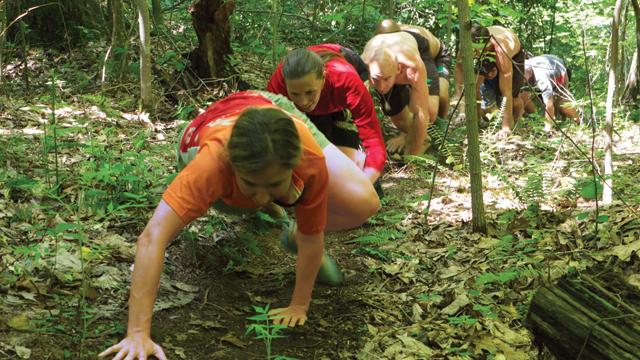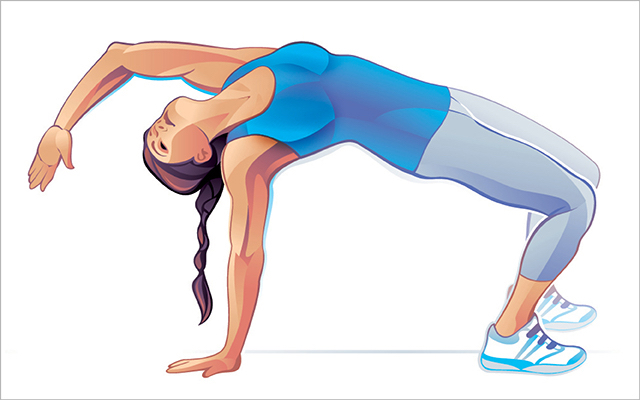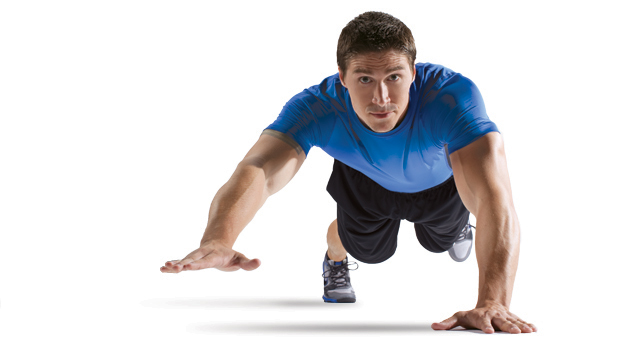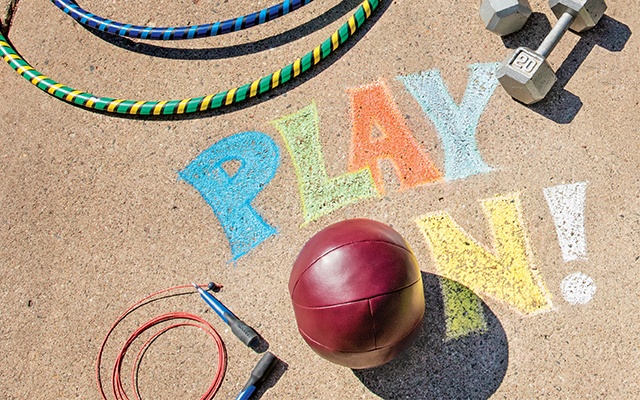I know I’m supposed to ride my bike instead of drive. I also know that it’s better for me to take the stairs instead of the elevator, and walk down the hall to talk with my coworker instead of emailing him. But the lure of comfort and efficiency often proves irresistible, and I have to admit that I often opt for the lazier route, figuring I’ll make up for it during my workout.
I’m not alone in my dependence on modern-day conveniences. And apparently our collective avoidance of doing things the old-fashioned way is hurting more than our muscle tone.
The consequences of living in a modern, technologically enhanced world are undermining both our bodies and our minds, says Frank Forencich, chief creative officer of Exuberant Animal, a Seattle-based health leadership organization. “In our ongoing effort to make ourselves more comfortable, we’ve lost out on two of the most essential components of health and happiness: direct interaction with nature and with other people.”
Many of us no longer do meaningful small-group activities of any kind. We no longer accomplish tangible, goal-oriented activities with our hands, or find time and energy for play. Shoes shield our feet from sensory input. Artificial light throws off our circadian rhythms, interfering with normal daily appetite fluctuations. We push buttons and depress gas pedals rather than running errands or physically moving things from place to place.
All told, we have created an “alien environment,” Forencich says, and many of our most serious modern health problems — depression, obesity, heart disease and cancer — can be attributed, at least in part, to a life spent largely in a kind of captivity.
While conventional gym workouts can help us up our activity and improve our fitness, most cardio and weight machines force us to move in fixed, sometimes unnatural ways. Limited-range movements like jogging and cycling overwork certain motor patterns and muscles while neglecting many others. Prescribed, repetitive routines can reduce the potential for spontaneity and joy in exercise.
In the last few years, fitness pioneers have been trying to address this problem by bringing a sense of both functional realism and an innate satisfaction back to exercise. They’re turning away from confining equipment and regimented training programs and returning to open spaces and natural movement.
Their goal isn’t just to create slimmer waistlines and rippling biceps, but integrated, full-body coordination, grace and an enhanced sense of connection — to our bodies, to nature and to other people.
These functional, “primitive fitness” innovators believe that the key to exceptional health lies in the activities and movement patterns of our ancient ancestors: crawling, climbing, jumping and running. The result is an exercise program that’s uniquely playful, kinetic, social and never the same from one day to the next. And it’s a fitness prescription that’s winning over droves of enthusiastic converts.
A Primitive Primer
When he explains primitive fitness to his clients, Forencich shows them a picture of a lush, unspoiled African landscape — the kind of environment from which all of humanity originated — and poses a simple question: “What kinds of skills and abilities might be necessary to thrive in an environment like this?”
The most intuitive answers — walking, squatting and climbing to gather food; carrying and lifting to build shelter; balancing, throwing, leaping and running to evade predators and hunt for prey — form the basis of primitive-style workouts. Coaches then combine these movements, one after another, in fast, exciting and unpredictable sequences.
Whether you do these movements in the wilds of Africa, a neighborhood park or the aerobics studio at your local health club, the effect is much the same: long-underused kinetic chains and neurological circuits begin sparking back to life. Your body grows stronger, your mind sharper.
Most of these exercises can be done in any open space with no equipment at all; the rest can be done either with found objects like stones and logs, or with basic gym equipment like medicine balls and kettlebells.
Precisely because of their deep roots in our evolutionary history, such movements can be uniquely effective in building health and fitness in the modern gym-goer. “You can do a ton of good for your body, work a lot of different muscles, and shred through calories in a very short amount of time exercising in this way,” says Phil Timmons, national program manager for group training at Life Time Fitness in Chanhassen, Minn. “And since the workouts always change, it does for your body what reading a new book does for your mind.”
Steve Bechtel, founder and co-owner of Elemental Training Center in Lander, Wyo., agrees: “We’re neurologically wired for this kind of movement. For that reason, all kinds of amazing things happen when you move your body through space like this. Studies have suggested that body-weight training is more effective for weight loss than using machines, for example. Athletes who train this way suffer fewer injuries and have greater career longevity. Plus, you’re doing so many different types of movement at once that your body and mind are continually engaged.”
This kind of neural stimulation is an essential component of “primitive” functional fitness and can go a long way toward combating the sensory sameness of everyday life. Physical play forces us to process a lot of sensory information very quickly — a simple, human survival skill we rarely call upon in life or in the typical workout.
Moving quickly while staying aware of obstacles, walls and other fast-moving people around you, for instance, requires an acute, dynamic awareness of your body and environment. Throwing and catching requires you to visually track an object as it travels toward you and away from you. And moving over varied terrain — when exercising on grassy surfaces or running trails, for instance — demands a moment-to-moment responsiveness from the entire body that we just don’t get walking on firm, flat surfaces.
“You can’t discard these movements and expect to survive in nature. They’re all vital, practical and adaptable to any number of circumstances,” says Erwan Le Corre, creator of the U.S.-based MovNat, which hosts weeklong outdoor fitness retreats in Brazil, Mexico, the United States and soon Thailand.
Such challenges to perception, balance and spatial awareness make primitive workouts an excellent way to improve proprioception (the ability to accurately and efficiently sense where you are in space relative to the objects around you).
This type of high-energy, dynamic movement stands in sharp contrast to muscle-isolating exercises like curls, cardio-machine training and programs designed around working certain muscle groups on certain days of the week. While effective in some ways, such workouts tend to treat the body as a series of disconnected parts — the biceps, the legs, the heart and lungs — as opposed to a single, unified whole, working together to produce movement.
“Ancient people didn’t exercise in any formal way,” Forencich explains. They were what might be called movement generalists — good at a lot of different kinds of movement, but never doing one thing too much or too long. “A Paleolithic man might have had to sit, run or climb in the course of a normal day, but he would never specialize in any of those activities.”
Coaches and teachers of primitive fitness also staunchly believe that when it comes to exercise, form follows function. “The way you look is a direct reflection of the quality of your movement. Learn to move well, and your body will look good,” says Le Corre.
Jon Hinds, whose Monkey Bar Gym facilities feature no machines and no mirrors, admits that he opened his primitive-fitness gym franchise because he was tired of the one-dimensional, narcissistic approach to fitness: “We’re often bombarded with a false picture of what true health and fitness is — like, that having huge muscles automatically means you’re fit.”
For most people, the basis for fitness motivation can be found in far more practical concerns. “I hear from parents all the time who want to be fit enough to keep up with their kids at the park and on the playing field,” says Timmons. “The primitive-style classes we offer at Life Time Fitness — which include Boot Camp and a number of functional-fitness group classes — help those parents not only keep pace with their kids, but give them a run for their money!”
Getting Primordially Fit
In practice, primitive, functional-fitness classes and workshops build strength, cardiovascular conditioning and coordination through a wide variety of full-body challenges. Students at Le Corre’s retreats combine primitive movements on natural, outdoor obstacle courses, switching smoothly from a sprint through the woods to a crawl through the sand to a vault over a log to a swim across a creek, continually refining each skill and transition.
In Forencich’s Exuberant Animal workshops, exercisers play games like “Rope-a-dope,” in which two people balance on one leg, hold opposite ends of a 10-foot rope, and attempt to topple each other by strategically pulling or slackening the rope.
Instructors of fitness classes at more conventional gyms — some of which have been on the spear edge of the functional-fitness trend for years — find creative ways to build similar fitness challenges in more familiar settings: “From the window of my office, I see people running up the hill beside the club,” says Mark Thom, vice president of fitness and nutrition for Life Time Fitness. “They carry weights, medicine balls, whatever they can drag outside from the club. It’s time-efficient, intense, and they’re having a great time.”
Timmons says he regularly witnesses the same kind of intensity and fun-loving enthusiasm. “Students in these classes sometimes do wild things: They drag one another across the floor on towels; push cars across the parking lot; work with sandbags and stones and tires for resistance. When I used to teach these classes, it was my goal to send them home with a good story to tell their friends!”
From the outside, such workouts may appear random and uncontrolled, but Le Corre points out that his outdoor workouts are scalable to any ability level, and that participants are warned never to “sacrifice technique for intensity.”
Bechtel concurs: “We still follow the basic strength-and-conditioning principles so that people are challenged and progress appropriately. We just do it in a way that keeps things changing. Routine is death to motivation and progress.”
Doing primitive-style workouts regularly can yield some impressive real-world results. Graduates of Le Corre’s five-day retreats tend to lose a few pounds during the week itself and, if they stick to his recommendations (including those regarding nutrition), report an almost effortless weight loss of 15 pounds or more in the weeks afterward.
Timmons reports that members of his primitive-style classes regularly improve on their monthly fitness tests, including body-fat percentage and tests of aerobic and anaerobic fitness. Hinds’s clients, on average, lose 17 pounds of fat and gain 5 pounds of muscle in their first 60 days, he says. Athletes who do his 12-week program typically improve their vertical jump by 8 inches and their broad jump by as much as a foot. “I think people are just more inclined to push themselves when they’re playing a game or when they’re working in a group,” says Thom. In a pro-social pro-intensity environment, he notes, “they’re that much more likely to give it everything they have.”
That certainly proved true for Jessica Rucker. The 37-year-old trainer from Madison, Wis., was overweight (36 percent body fat) and sedentary when she started working out at Hinds’s gym a few years ago; now she’s down to 16 percent body fat and can do 20 chin-ups. “Many people, especially women, don’t think they can do a chin-up, climb a rope or walk on their hands,” says Rucker. “At our gym, we ask, ‘Why not? Who said you can’t do those things?’”
Fun: The Missing Link to Fitness?
For some people, the gym is a place to turn inward, block out distractions and focus on themselves, but many fitness coaches believe that the social connections one can make during communal exercise and play are no less important to health and happiness than hitting a personal best on the bench press.
Just as our ancient ancestors needed strong social relationships to survive and thrive, Forencich believes that a sense of belonging — to a modern “tribe,” or social group — is an essential, and often neglected, element of optimal health.
Physical play with others, he believes, fosters this kind of closeness: “We’re seeing more and more evidence that when mammals play more, they learn and socialize better.”
Thom notes that at Life Time Fitness, participants in group fitness classes that emphasize interaction and cohesion tend to be impressively supportive of one another. “Those groups stay together for years,” he says. “They host parties where they eat healthy food together. If someone doesn’t show up for a 6 a.m. class, other members of the class will call that person to ask where they are.”
The social atmosphere at Hinds’s gym has been great for Rucker’s mood and day-to-day perspective, she says. “The place has no mirrors, so you literally can’t focus on yourself. The work is partner-based. It’s hands-on. You want a great way to get out of your head? Help someone else!”
Too often, in the quest for maximum efficacy, people gravitate toward workouts they don’t enjoy, believing they have to suffer to meet their goals. But primitive-fitness advocates emphasize that a sense of fun is essential and just might be the missing ingredient people need to succeed. This is one reason that Josh Leeger, MS, a trainer from San Francisco, incorporates Exuberant Animal games into his clients’ programs on a regular basis. He uses standard measures of health and fitness to determine the effectiveness of his programs, but he looks for enjoyment as well. “If my clients laugh during their sessions,” he says, “I believe I’ve done my job.”
Primitive fitness may not appeal to everyone: The relative lack of structure in some of these wild workout programs can be a turn-off for individuals who prefer the predictability of a regular date with a treadmill. And the intensity of boot-camp-style classes may prove a bit much for those unaccustomed to going all out. On a steep, rocky trail run up a mountain, you can’t simply push the “stop” button if you get tired.
Primitive-fitness experts readily acknowledge that their workouts also require a bit more forethought and creativity than some gym-goers may be accustomed to mustering. If a deconditioned person is having trouble on an exercise bike, for example, he can simply lower the resistance. Nature isn’t always so forgiving.
The solution is to take it slowly and gradually: Don’t go outside and try to carry a boulder up a mountain on your first day, or start tossing a 20-pound medicine ball around the gym without some instruction. (See “Primitive Practices” below for some tips on how to begin integrating a few primitive concepts into your regular routine.)
Heeding the Call
The allure of improved fitness and useful new skills may provide ample motivation to give primitive-inspired fitness training a try. The biggest reward of all, however, may have less to do with a litany of distinct benefits than with an integrated, synergetic sense of well-being and engagement.
By emphasizing a whole-person experience in a group setting, primitive fitness can serve as a powerful antidote to isolation — both for the muscles and for the individual. In our harried and disjointed modern-day lives, feeling a sense of connection — to our environment, our community, our heritage or even our own bodies — can seem a regrettably rare thing. Yet it’s a quality that many primitive-fitness workouts deliver in spades.
“We spend so much time in front of TVs and computers, taking in information that someone else is feeding us,” says Bechtel. “Touching the earth, seeing things with your own eyes, provides an opportunity to live firsthand. It’s critical that people step away from the iPad on a regular basis, go out and feel alive again. This kind of exercise is more than just a workout — it’s cathartic.”
Primitive Practices
Want to know how to incorporate some primitive touches into your workout? Here are a handful of common themes you can draw on for a foray back to your primordial roots:
1. Act Like an Animal
The last few years have seen a return to multijoint movements like squats, lunges and pushups at the gym — and that’s good. All those exercises are variations on evolutionary movements. If you’re up for it, however, it’s still possible to go even more basic:
- Instead of bench-pressing, crawl on all fours (30-second bursts on all-fours sprinting on a basketball court is tough for just about anyone).
- Instead of rowing, climb (experiment with going hand-over-hand from one end of the chin-up bar to the other, keeping one or both feet on a box, if necessary).
- Don’t limit movements to just your upper body or lower body — find exercises that use both, like jumps and carries of all kinds, medicine-ball throws, lifts, and slams.
- Try adding twists, throws, jumps and explosive force to your favorite strength-training movements.
“The key is to use as many different muscle groups at a time as possible,” says Frank Forencich, chief creative officer of Seattle-based Exuberant Animal.
2. Step Away From the Machine
“It’s ironic that we’re at a point where people believe they need a machine to exercise when it’s really so much more effective to just move your body through space,” says Steve Bechtel, founder and co-owner of Elemental Fitness in Lander, Wyo.
Machines can be useful for injury rehab and for an occasional change of pace, but they don’t do much for your proprioception — your ability to sense and control where you are in space — or for usable, real-world strength and fitness.
Keep equipment as basic as possible: Medicine balls, kettlebells, dumbbells, jump ropes, sturdy wooden boxes and a set of stairs is plenty for a killer workout.
3. Go Tribal
“Playing together creates and enhances positive social relationships,” says Forencich. Try to find ways to exercise with groups of people, whether in a primitive-themed class (some “boot camps” are great options), in a low-stress team sport that requires many different types of movement (like ultimate Frisbee), or getting together with friends at a local park and improvising some primitive moves. (Anyone tried a three-legged race recently?)
4. Take It Outside
Health clubs, rec centers and other large, indoor spaces offer year-round accessibility and convenience, but getting outside now and then — running on a trail, for instance — offers challenges to balance and coordination that you just can’t get on a treadmill or track.
There’s always the possibility when you’re in the great outdoors that you’ll encounter a tree worth climbing, a stream worth fording or a rock worth hefting.
Parkour enthusiasts — who climb, jump over and scramble up manmade objects like bridges, benches, fences and walls for fun and exercise — have shown that you don’t need a national forest in your backyard to enjoy training in the fresh air.
5. Go Exploring — Inside
Even within the confines of your gym, primitive-fitness opportunities abound. Have you tried climbing the service stairs carrying a couple of kettlebells? Jumping back and forth over a cone while holding a medicine ball? Pushing a partner across the gym floor as he resists, then letting him push you back? Be willing to experiment a little.
6. Grab a Movement Snack
For the time-pressed, Forencich recommends spending five minutes at a time — even up to 10 times a day — moving: walking, reaching, twisting, swinging your arms. “There’s no reason why an exercise program has to be confined to any particular time or place,” he says. “If you can get past your inhibitions, you can have a great mini-workout in an airport departure lounge while waiting for a delayed plane.”
Primitively Prenatal
Fitness enthusiasts aren’t the only ones benefiting from the growing interest in a more primitive, holistic connection to our bodies. Across the country, a growing number of expectant mothers are discovering reserves of previously untapped strength in prenatal yoga classes.
The wavelike alternation between rest and intensity in a yoga practice, says Sarah Longacre, chief executive yogini at Blooma Prenatal and Postnatal Yoga Studio in Edina, Minn., makes it a perfect way to prepare for labor and natural childbirth. “At the end of class we do something called the Goddess Pose, which we hold for three minutes. I tell my students, ‘You’re going to want to give up. But if you keep connecting to your breath and deepening into the pose, you’ll get through it.’ Many people tell me they couldn’t have gone through natural childbirth without that pose.”
Childbirth forces the “thinking” mind to shut down, and a more primitive, intuitive brain to take over, adds Longacre. “You can’t think your way through a yoga practice, and you can’t think your way through birth. That more primitive side allows you to access inner reserves of strength that you don’t normally use.”
Like her peers in the growing world of primitive fitness, Longacre believes that our comfortable lives have cut us off from a more primitive, less rational way of thinking and being — a mindset that can be invaluable in making natural childbirth a life-changing, powerfully positive experience, rather than something to be feared or dreaded. “In our culture, we’re not used to being pushed, physically: We don’t hunt. We sit all the time and we don’t squat, so our hips are closed,” she explains. “The couch could possibly be a big factor for why Cesarean births are on the rise in this country. Babies don’t favor this position either.”
This article originally appeared as “Wild Workouts”.




This Post Has 0 Comments